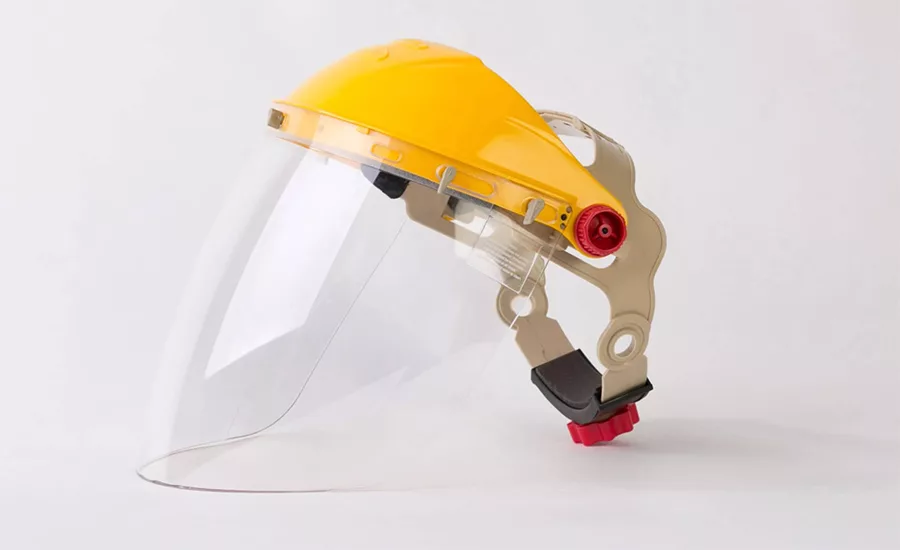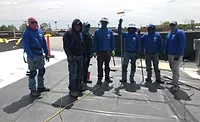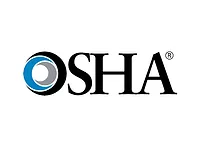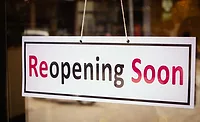Shielded Safety: Breaking Down COVID-19 Face Protection for Roofing Contractors

Face masks aren’t the only way to stop the spread of COVID-19. Here are some viable alternatives that can keep workers safe.
Most of us working in the safety and health industry are aware that the viral pandemic is more than likely to evolve, rather than devolve, in the months and years to come. At least, that is what we should prepare our workforce to encounter through constant analysis and training.
The most efficient of the four routes-of-entry for hazardous substances into the human body is always inhalation, followed by absorption, ingestion and injection. This is particularly true when the hazardous substance is a virus that exists effectively on the nanoscale. Every week there are new virologic revelations concerning the biology of SARS-2-CoV-19. While almost everyone agrees uncertainty is the nature of the new normal, it makes it difficult to confidently train your workforce in consistent engineering controls, Safe Work Practices and dependable PPE.
An unfortunate sidebar to viral transmission rate is the onset of the “politics of masks.” While one has nothing physically to do with the other, the fact persists that, unlike a respirator, if I wear a mask in public it is a physical manifestation of my care for the health of others, rather than my own. Conspiracies notwithstanding, it is a mystery to me how science can genuinely be at odds with pseudo-philosophy on totally separate battlefields, when it is evident that an outbreak anywhere on the planet is considered an outbreak everywhere. As a result, I decided to look at the practicality of wearing a mask and/or shield while working on a conventional construction site.
Unlike industrial or office workers, the construction worker must contend with both indoor and outdoor environments with varying temperatures and inconsistent environmental conditions (heat, cold, rain and snow). In addition, construction workers can find themselves working alone onsite one moment and in a gang of four to six workers an hour later.
As we approached October 2020, we were told to expect a potential pandemic nightmare combining ongoing COVID-19 infections with the onset of H1N1influenza (Type A or B) season. Suffering the debilitations of one disease while succumbing to the other could have devastating effects on those with compromised auto-immune systems. We’ve been advised to expect an inevitable inflation of the nation’s fatality rate. We have seen varying increases in construction starts as different states begin to open up (or close down) their economies. It has been scientifically proven, by those with sufficient experience and training, that a double-layer cloth mask worn over the mouth and nose protects other persons on site by greatly reducing the transmission rates of SARS-2-CoV-19.
However, as most physical laborers and professional athletes realize, wearing a tight, double-layer mask designed to trap moisture in extremely hot and humid weather while either pouring cement, framing a structure or shingling a roof can impair respiration, reduce oxygenation, promote heat stress, and under extreme conditions, possibly contribute to a lethal heat stroke. Whenever working outdoors alone or maintaining proper social distance in a work gang (where feasible), I would suggest an alternative use of a full coverage face shield that completely covers the eyes, nose and mouth.
Under proper outdoor conditions, full-face shields would have the advantage of interrupting (deflecting) exhaled, bio-aerosols while 1) allowing the worker to more easily inhale fresh air, and 2) limiting re-breathing exhaled carbon dioxide during stressful activities, which can cause increased respiration rates. Many experts have speculated that carbon dioxide will not build up behind a paper or cloth mask “under normal conditions” in sufficient concentrations to be debilitating. But as a physically stressed worker sweats and exhales water vapor, the efficiency of a new, clean, dry cloth mask drops proportionally as it absorbs moisture between its fibers, requiring more frequent change-outs with dry masks. However, if a double-elastic strap mask or “gaiter” is worn around the neck, the outdoor worker may easily slide it up underneath the face shield and over their nose and mouth whenever and wherever adequate social distancing becomes infeasible.
Another option I have found would be to don goggles with a lower face shield attached. After hours of use, I find they are less cumbersome and more stable than a full-face shield. Full-face shields and goggles with nose/mouth shields not only help prevent cross-contamination of your coworkers, but also help protect us from inhaling and/or absorbing contaminated airborne bio-aerosols. Recent viral field studies have shown that, depending on conditions, COVID-19 viruses may travel further (> 12 feet) and remain suspended in air for longer periods than previously suspected. In addition, wearing a “shield” can also prevent us from inadvertently touching our faces with contaminated hands during the work shift.
FULL-FACE SHIELDS
This form of PPE can be purchased with either a ratchet headset or a hard-hat attachment, depending on your job’s PPE requirements. Although well-balanced, they do add weight, which may require tightening the ratchet strap to keep it properly positioned while working. Additionally, they meet the extensive ANSI Z87.1 standards for physical eye protection.
The most effective full-face shields used to protect ourselves and our co-workers from viral exposure have a compound-curve design, enclosing the breathing zone below the chin and beyond the mandibles. This forms a more effective “spit shield” for both outgoing and incoming airborne droplets. Although the marketplace offers a wide variety, three full-coverage face shields I recommend are:
- Honeywell/Uvex Bionic Face Shield® w/Hard Hat Adapter and Clear Polycarbonate Visor (#S8505)
- Honeywell/Uvex TurboShield® w/Hard Hat Adapter and Clear Polycarbonate Visor (#S9500)
- MSA Defender® Face Shield hard hat frame (#10005383) with MSA Tinted Polycarbonate visor (#10154949)
As all three shields offer a tip-up feature, I found the hardhat-mounted Uvex Turboshield® to be the most comfortable for up to a four-hour period. It also proved easy to raise the face shield in order to slide a double-elastic mask or neck gaiter into place when working alongside others. Some of the more expensive face shields have advertised features such as: anti-fogging; anti-static; enhanced scratch resistance and, what I enjoyed most, photochromic lenses.
GOGGLES WITH LOWER SHIELDS
With various individual features, this style of PPE is based on an ANSI-Z87 approved pair of goggles with either a detachable or tip-up style of lower face shield. It’s a more lightweight alternative to a full-face shield on a hard hat. Three goggle/face shield combinations I recommend are:
- Pyramex® Goggles with Tip-Up Face Shield (#PYR-GG504TShield)
- MSA Vertoggle® Goggle/Face Shield combo w/detachable face shield (#10150069)
- Bolle Atom® SafetyGoggle w/Bolle Unvented Blue Visor (#BOL-40092-VSKIT)
As with full-face shields, I recommend wearing a neck-gaiter style mask below the chin with either the snap-on or tip-up goggle/face shield combo. Thereby, when other crew members approach near 6 feet, you pass through a “choke point” such as a gate or trailer, or assemble during a coffee break or tail-gate meeting, the gaiter mask can be temporarily donned over the nose and mouth, while the goggle and shield continue to protect the eyes.
Looking for a reprint of this article?
From high-res PDFs to custom plaques, order your copy today!







